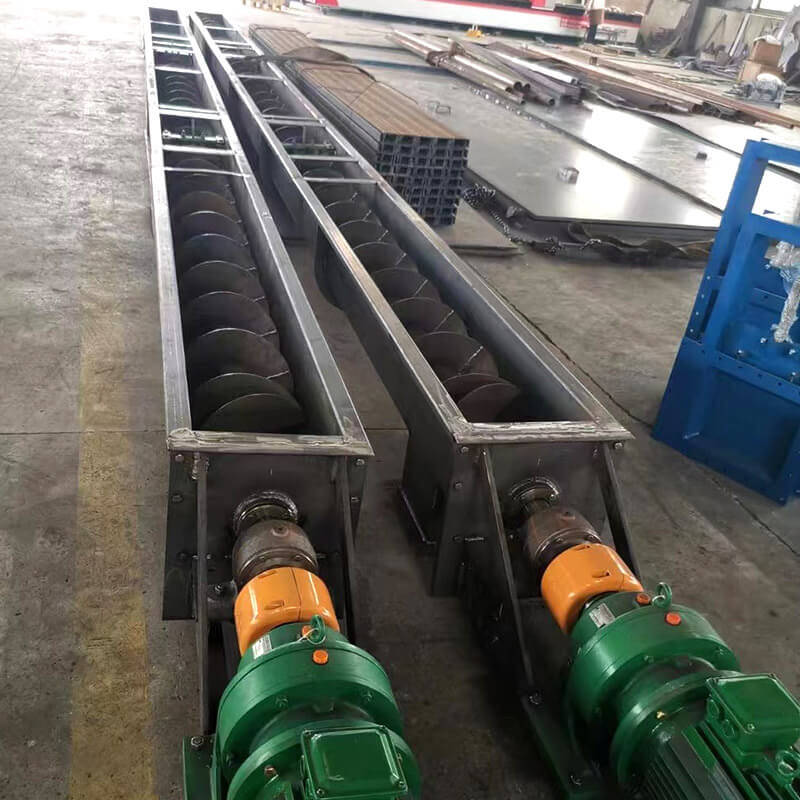はじめに
のようなバルク材料の移動に関しては 穀物, セメントの汎用性に匹敵するソリューションはほとんどありません。 スクリューコンベア (とも呼ばれます オーガーコンベヤー).しかし、この産業用コンベアは一体どのように作動するのでしょうか?他のコンベヤと何が違うのでしょうか?選ぶ前に知っておくべきことは?
✔ スクリューコンベアとは何ですか? - コア・コンポーネントと用途
✔ スクリューコンベアの仕組み - アニメーション図解付き
✔ 主要6タイプ およびその理想的な用途
✔ スクリューコンベア vs. スクリューコンベア バケットコンベヤー - 決定的な違い
✔ よくある問題 そしてそれを避ける方法
リーディングカンパニーとして スクリューコンベヤメーカーDarko Machineryは、何百社ものお客様のマテリアルハンドリングの最適化をお手伝いしてきました。専門家の洞察については、こちらをお読みください。 エンジニアへのお問い合わせ をご覧ください。
1.スクリューコンベアとは
スクリューコンベア(またはオーガコンベア)は、回転するらせん状の羽根を使用して、パイプや溝を通して粉体、粒子、半液体の材料を移動させる機械システムです。
主要コンポーネント
| パート | 機能 | 素材オプション |
|---|---|---|
| トラフ | 輸送中に材料を含む | 炭素鋼、ステンレス鋼、ポリエチレン |
| スクリューフライト | 材料を移動させる回転刃 | 硬化鋼、耐摩耗コーティング |
| ドライブユニット | 回転力を提供 | 電気、油圧、または空気圧モーター |
| ベアリング | サポートスクリューの回転 | 自己潤滑性、密閉設計 |
| インレット/アウトレット | 材料の出入口 | フランジ、スライディングゲート、カスタム設計 |
スクリューコンベアはどこで使われていますか?
✔ 農業: 穀物、飼料、肥料の取り扱い
✔ 食品加工: 小麦粉、砂糖、粉類
✔ 廃水: 汚泥脱水、バイオソリッド
✔ 建設 セメント、砂、ドライモルタルの輸送
✔ 鉱業だ: 石炭、鉱石、鉱滓輸送
*(プロのアドバイス:食品用には、サニタリー仕上げの304/316ステンレスをお選びください。)
2.スクリューコンベアの仕組み
螺旋軸が回転すると、材料の重力と溝壁との摩擦力により、材料は、回転できないナットが回転スクリューに沿って並進移動するように、羽根の押力の下でコンベヤの溝底に沿って前進することしかできません。原料の主な駆動力は、螺旋状の羽根が羽根の接線方向に沿って軸方向に回転するときに発揮する上向きと前向きの力です。
スクリューシャフトを良好な張力状態に保つため、一般的に駆動装置と排出口はコンベヤの同じ端に配置され、供給口は他方の端の尾部にできるだけ近い位置に配置されます。回転するスパイラル羽根が搬送物を押し、搬送物がスパイラル羽根と一緒に回転しないようにする力は、搬送物自体の重量と、搬送物に対するスパイラルコンベヤハウジングの摩擦抵抗です。
ブレードの表面形状は、固体表面、ベルト表面、ブレード表面など、搬送物の種類によって異なります。スクリューコンベヤのスクリュー軸には、材料とともにスクリューに軸方向の反力を与えるため、材料移動方向の端部にスラストベアリングがあります。機械が長い場合は、中間サスペンションベアリングを追加する必要があります。
3.スクリューコンベアの種類
| タイプ | 最適 | メリット | 制限事項 |
|---|---|---|---|
| ホリゾンタル | 短距離材料移送 | 低コスト、メンテナンスが容易 | 最大15°傾斜 |
| 傾斜(≤45) | 昇降材料 | 省スペース設計 | 45°で容量低下~30% |
| 縦型 | 高揚力アプリケーション | コンパクトなフットプリント | より高い電力ニーズ |
| シャフトレス | 粘着性/スラッジ材料 | センターシャフトなし=目詰まりなし | 研磨材は不可 |
| フレキシブル | 多方向ルーティング | ポータブル、簡単なインストール | 低容量 |
| チューブラー | ほこり・刺激の強いもの | 完全密閉設計 | 掃除がしにくい |

4.スクリューコンベアとバケットエレベーターの比較:主な違い
| 特徴 | スクリューコンベア | バケット・エレベーター |
|---|---|---|
| 素材の種類 | 粉末、顆粒、スラッジ | ほとんどが乾燥顆粒 |
| 傾斜能力 | 45°まで(標準) | 垂直(90) |
| 容量範囲 | 1-300 m³/h | 5-500 m³/h |
| メンテナンス | 低い(可動部が少ない) | 中程度(ベルト/バケットの摩耗) |
スクリューコンベヤを選ぶときは?
取り扱い 粘着性のあるもの、壊れやすいもの
必要性 可変放電点
必要 粉塵・臭気の封じ込め
5.スクリューコンベアのよくある問題と解決策
問題1:材料の蓄積/詰まり
原因
粘着性物質(湿った汚泥など)
不適切なスクリューピッチ設計
トラフの過負荷
解決策
→ 使用 シャフトレススクリューデザイン
→ インストール クリーンアウトアクセスポイント
→ 追加 バイブレーターまたはエアーナイフ
問題2:過度の磨耗
原因
研磨材(砂、鉱石)
高回転
材料のアライメント不良
解決策
→ 申し込み 耐摩耗ライニング (セラミック、ARスチール)
→ 削減 動作速度 by 20%
→ 使用 硬化フライトエッジ
問題3:シールの不具合
原因
埃の浸入
ベアリングのミスアライメント
熱膨張
解決策
→ へのアップグレード ラビリンスシール
→ インストール 状態監視センサー
→ 使用 自動調心ベアリング
プロのスクリューコンベヤメーカーとして、カスタマイズされた設計ソリューションを提供します。コンベヤーに関するご質問やご要望がございましたら、下記までご連絡ください。 お問い合わせ-当社のエンジニアがお客様のニーズに合わせて最適なソリューションをご提案します。

